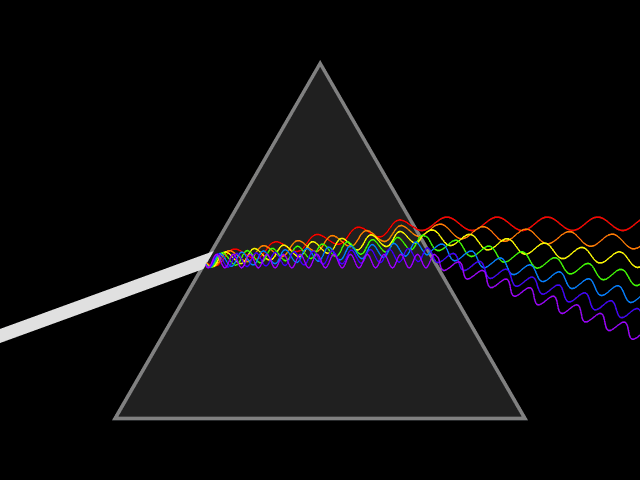Fayl:Light dispersion conceptual waves.gif
Qiyofa
Light_dispersion_conceptual_waves.gif (640 × 480 piksel, fayl hajmi: 1,14 MB, MIME tipi: image/gif, looped, 90 frames, 4,5 soniya)
Fayl tarixi
Faylning biror paytdagi holatini koʻrish uchun tegishli sana/vaqtga bosingiz.
| Sana/Vaqt | Miniatura | Oʻlchamlari | Foydalanuvchi | Izoh | |
|---|---|---|---|---|---|
| joriy | 17:09, 2010-yil 6-aprel |  | 640 × 480 (1,14 MB) | Kalki | Reverted to version as of 04:14, 27 February 2008 |
| 17:07, 2010-yil 6-aprel |  | 640 × 480 (1,17 MB) | Kalki | Reverted to version as of 03:31, 27 February 2008 | |
| 04:14, 2008-yil 27-fevral |  | 640 × 480 (1,14 MB) | LucasVB | ||
| 03:31, 2008-yil 27-fevral |  | 640 × 480 (1,17 MB) | LucasVB | {{Information |Description=Copnceptual animation of dispersion of light in a prism. Using waves. |Source=self-made |Date=2008-02-27 |Author= Lucas V. Barbosa (aka Kieff) |Permission=Public domain |other_versions=Light_dispersion_conceptual. | |
| 04:10, 2007-yil 24-dekabr |  | 640 × 480 (348 KB) | LucasVB | {{Information |Description=Dispersion of light inside a prism. Now with waves. |Source=Self |Date=2007-12-24 |Author=Lucas V. Barbosa |Permission=Public Domain |other_versions=Image:Light_dispersion_conceptual.gif }} |
Fayllarga ishoratlar
Bu faylga quyidagi 2 sahifalar bogʻlangan:
Faylning global foydalanilishi
Ushbu fayl quyidagi vikilarda ishlatilyapti:
- af.wikipedia.org loyihasida foydalanilishi
- am.wikipedia.org loyihasida foydalanilishi
- ar.wikipedia.org loyihasida foydalanilishi
- ary.wikipedia.org loyihasida foydalanilishi
- ast.wikipedia.org loyihasida foydalanilishi
- as.wikipedia.org loyihasida foydalanilishi
- azb.wikipedia.org loyihasida foydalanilishi
- az.wikipedia.org loyihasida foydalanilishi
- ba.wikipedia.org loyihasida foydalanilishi
- bcl.wikipedia.org loyihasida foydalanilishi
- bg.wikipedia.org loyihasida foydalanilishi
- bn.wikipedia.org loyihasida foydalanilishi
- bn.wikiquote.org loyihasida foydalanilishi
- bs.wikipedia.org loyihasida foydalanilishi
- ca.wikipedia.org loyihasida foydalanilishi
- ceb.wikipedia.org loyihasida foydalanilishi
- cs.wikipedia.org loyihasida foydalanilishi
- cy.wikipedia.org loyihasida foydalanilishi
- da.wikipedia.org loyihasida foydalanilishi
- el.wikipedia.org loyihasida foydalanilishi
- en.wikipedia.org loyihasida foydalanilishi
Ushbu faylni koʻproq global foydalanishdan koʻring.


